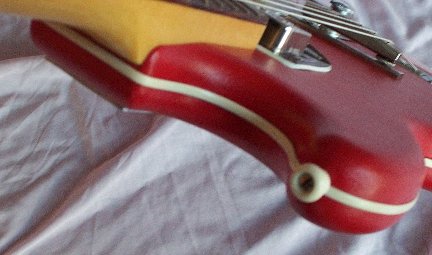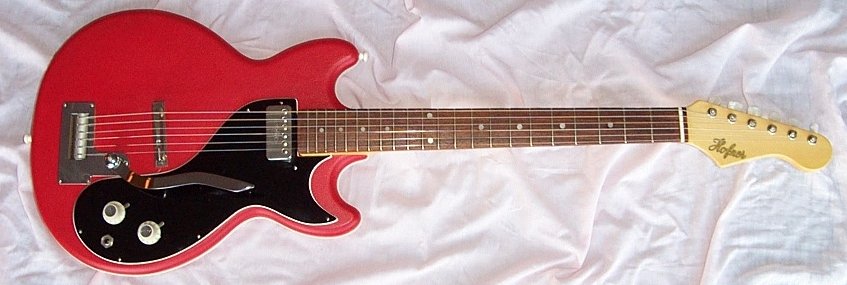

This guitar was
acquired by Guitar and Music Exchange, Manchester some 12 months or so before I
bought it. I had heard, through the grapevine, that a mint Colorama had surfaced,
almost as soon as it went on display. For some reason I dismissed it
as being a budget solid and therefore of no interest. It was only after seeing
the guitar on display at the Northern Guitar Show at UMIST, Manchester during
May 2002 that I realised that the guitar was in a time warp! The last time that
I had seen any Colorama in that sort of condition was back in 1963! The original
Selmer leather strap was attached to the guitar and...........the original
tape-wound (wound 3rd) strings were fitted. The guitar was just as when it had
left the factory - apart from one thing - the white piping around the body had
shrunk and pulled away from its slot at locations top and bottom of the guitar's
waist. I have seen this often with vinyl covered Hofners; an inevitable
consequence of their age, I suppose. I decided to take a chance on being able to
rectify this defect, and very quickly struck a deal with Nev, the owner of
Guitars & Music Exchange.
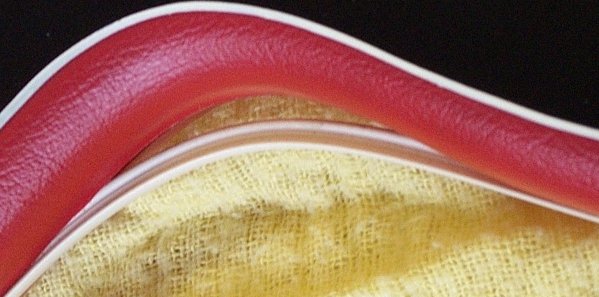
On getting the guitar home, I found that correcting shrunk piping is very simple. Just release the ends of the piping from the strap button at the bottom of the body, carefully pull out the piping from its slot around the body until the waist is reached, hence releasing the tension in the piping, and re-insert the piping back into the slot making sure that it fits correctly in the area of the waist. Ok, the piping fails to return back as far as the strap button by about 1/2", but that is just not noticeable in that area.
Plug-in and there isn't even any dust crackle from the pots. The guitar, as far as I am concerned, is now 100%. I suppose that I must confess to changing those original tape-wound strings straight away. A little too much tension for my playing style, and after nearly 40 years, it really was time for a string change, even by my standards!
While the strings were off, I decided to remove the scratchplate and tremolo in order to check up on body construction. I could vaguely remember from the 60's that the vinyl covered Coloramas have a rather strange body construction, and low-and-behold, I found that my memory still serves me well! The photo below clearly shows what I believe is called a blockwood core of glued (spruce?) strips, sandwiched between two veneers top and bottom. This is obviously a cheap alternative to solid timbers, but one that conventional cellulose paint would have difficulty hiding. Hence the use of a vinyl covering. Other Hofner solids such as Models 185, 173, and 176/Galaxie were in many cases also vinyl covered. However, I think that this was for a different reason, and not necessarily to cover up the body construction on these better quality guitars. They use either a full depth solid slab timber body, or veneers top and bottom with a solid wood core, both of which are able to take a painted finish. The commonly held theory is that Hofner were producing solid guitars at such a high rate in the 60's that they just did not have the time to let a painted finish dry! Hence, the vinyl coverings pioneered on the Coloramas for one reason were adopted later on the better quality guitars for possibly another reason.
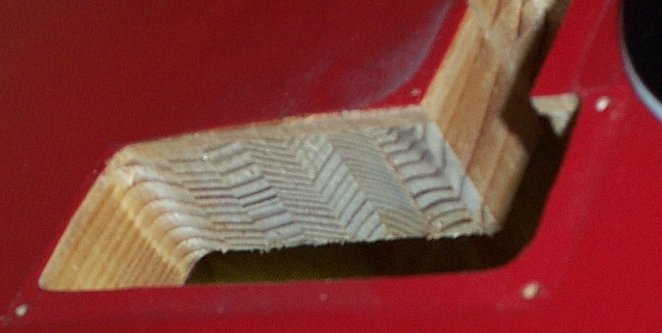
The previous model of the Colorama had a solid body construction, using what looks (and sounds) like mahogany. - See my 1961 Colorama, and the Colorama Factfile.

One "diamond logo" pickup is fitted to this guitar, although a two pickup version was also available. This particular guitar has one rotary control for volume and one for tone, but slightly earlier vinyl covered Coloramas were fitted with the Hofner rectangular control consul. The resultant tone is not as rich and bluesy as my '61 mahogany bodied Colorama, but it is still not bad for a guitar with a blockwood body.
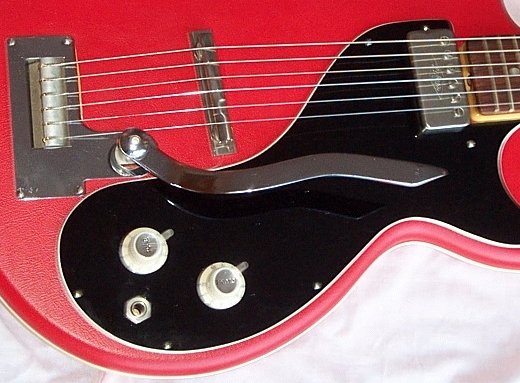
The tremolo arm is the standard Hofner unit fitted to their solid guitars from about 1962 onwards. On the Colorama, it was an optional extra at a cost of a further 7 guineas. (£7.35) It is a very simple rotating drum and single spring unit, but surprisingly enough it stays in tune fairly well. The spring has been balanced against the original heavy gauge strings, and hence the upward movement is restricted with modern light gauge strings.
The chrome bridge is adjustable for lowering/raising the strings only. Intonation is adjusted by moving the bridge unit backwards and forwards on the top of the body until a passable result is achieved.
The neck is made from a single solid piece of maple, and is bolted on to the body with the usual four screws and chromed steel back plate. The fingerboard is made from a rather mediocre piece of what is probably rosewood. It has a rather light, powdery appearance though, in common with other fingerboards on budget Hofners. The neck is reinforced with a truss rod; adjustment being made at the body end of the neck. No zero fret is fitted; this feature being dropped on all Hofner solids from about 1962 when the bolt-on necks were introduced.
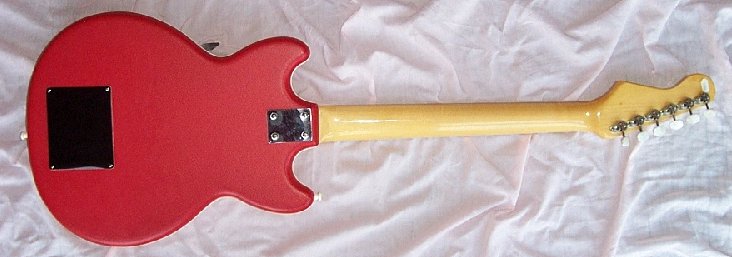
The machine heads are single units, but perhaps the cheapest looking that I have seen on any Hofner. They work fine on this guitar, but remember that it has hardly been used in 40 years! Ferules are fitted through the headstock to accommodate the tuners' barrels however. Unusual for a Hofner, the tops of the barrels are slotted in order to help prevent string slippage. Unlike the traditional Fender tuners, a string hole is also provided across each barrel's diameter.
The serial number is printed on a rather crude paper sticker located on the back of the headstock. Numbers on the headstocks of Selmer distributed solids are usually stamped into the wood. A filled hole is visible in the rear of the headstock - presumably for supporting the neck whilst having the lacquer applied.
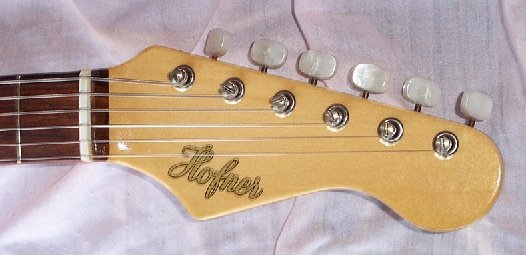
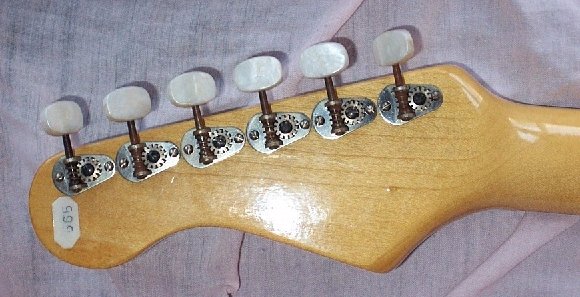
I have to say that the previous model of Colorama, i.e. the
1961 set-neck, twin cutaway version with the "solid" solid
mahogany body, is much the best Colorama made in my opinion. However,
despite the various cost saving measures adopted by Hofner for the 1962/63
bolt-on neck Colorama's construction, this is still a well made and workmanlike
instrument. It is extremely pleasant to play, being helped in this regard by its
slim, light body and comfortable neck. In 1962, 63, and 64, the Colorama was
selling like hot cakes in the UK, and it's not hard to see why. Before
dismissing the Colorama as yet another "budget solid", please remember
that this little guitar was the starting point for many a future guitar hero!
